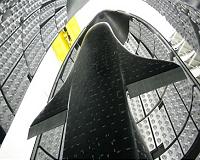 |
Tokyo (AFP) April 27, 2010 Japan is to launch a "space yacht" propelled by solar particles that bounce off its kite-shaped sails, the country's space agency said Tuesday. A rocket carrying the Ikaros -- an acronym for Interplanetary Kite-craft Accelerated by Radiation of the Sun -- will blast off from the Tanegashima space centre in southern Japan on May 18. "Ikaros is a 'space yacht' that gets propulsion from the pressure of sunlight particles bouncing off its sail," Yuichi Tsuda, space systems expert at the Japan Aerospace Exploration Agency (JAXA), told journalists. The flexible sails, which are thinner than a human hair, are also equipped with thin-film solar cells to generate electricity to create "a hybrid technology of electricity and pressure", Tsuda said. "Solar sails are the technology that realises space travel without fuel as long as we have sunlight. The availability of electricity would enable us to navigate farther and more effectively in the solar system." Ikaros, which has cost 1.5 billion yen (16 million dollars) to develop, will be the first use of the technology in deep space, as past experiments have been limited to unfolding its sails in orbits around the Earth, said Tsuda. JAXA plans to control the path of Ikaros by changing the angle at which sunlight particles bounce off the silver-coloured sail. Ikaros will be a short cylindrical shape when it is released into space and will then extend its 14-metre (46 foot) sail, JAXA said. The name of the spacecraft alludes to Icarus, the figure from Greek mythology who flew too close to the sun and fell into the sea, but Tsuda promised that "this Ikaros will not fly into the sun". The same rocket will also launch Japan's first satellite bound for Venus, called the Akatsuki, or PLANET-C, which will work closely with Venus Express, a satellite sent earlier by the European Space Agency. In coming years, JAXA may launch other bold projects. An expert panel to the government has proposed Japan send a wheeled robot to the moon in five years and build the world's first lunar base by 2020, a Strategic Headquarters for Space Policy official said Tuesday. Under the plan, the robot's tasks would include setting up an observation device, gathering geological samples and sending data back to Earth. The robot would also set up solar panels to generate energy, the official said. The expert panel initially considered sending a two-legged humanoid but judged a "rover-type" robot more practical. "It is still difficult for a biped robot to walk on a bumpy surface, even on Earth," the official said. The team also envisions building the world's first station on the moon by about 2020, which would be staffed by advanced wheeled robots, he said. The group estimates the unmanned mission would cost Japan 200 billion yen (two billion dollars) over the next 10 years. The 20-member team -- made up of experts from JAXA as well as business and academia -- advises Transport Minister Seiji Maehara. It plans to submit a report to Maehara, the minister in charge of space exploration, by late June, which would be discussed at the Strategic Headquarters for Space Policy, chaired by Prime Minister Yukio Hatoyama.
Share This Article With Planet Earth
Related Links Great page on Solar Sailing Space Tourism, Space Transport and Space Exploration News
 USAF Officials Launch Atlas V Carrying X-37B
USAF Officials Launch Atlas V Carrying X-37BCape Canaveral AFS FL (AFNS) Apr 26, 2010 Members of the 45th Space Wing launched a United Launch Alliance-built Atlas V Evolved Expendable Launch Vehicle carrying an X-37B Orbital Test Vehicle at 7:52 p.m. EDT April 22. The X-37B, making its first space flight, will provide a flexible space test platform to conduct various experiments and allow satellite sensors, subsystems, components and associated technology to be efficiently ... read more |
|
| The content herein, unless otherwise known to be public domain, are Copyright 1995-2010 - SpaceDaily. AFP and UPI Wire Stories are copyright Agence France-Presse and United Press International. ESA Portal Reports are copyright European Space Agency. All NASA sourced material is public domain. Additional copyrights may apply in whole or part to other bona fide parties. Advertising does not imply endorsement,agreement or approval of any opinions, statements or information provided by SpaceDaily on any Web page published or hosted by SpaceDaily. Privacy Statement |